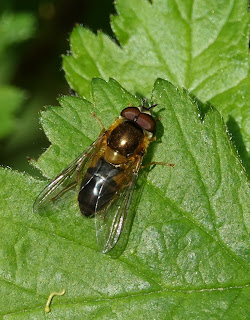Before I was driven off by a heavy shower I noted some flowering ivy, always a good nectar source at this time of year. Two attractive hoverflies were visiting the flowers - Myathropa florea and Volucella zonaria. The latter is our largest hoverfly and has the common name of hornet hoverfly because of its close resemblance to and association with hornets. It only arrived in Northants in the mid 2000's but is now reported quite frequently, especially from gardens growing Buddleja.
Diptera are the true, or two-winged flies. They are a sadly neglected group but with over 7000 species in the UK, there are plenty of opportunities to study and record them.
Saturday, 16 September 2017
Mid September 2017
Before I was driven off by a heavy shower I noted some flowering ivy, always a good nectar source at this time of year. Two attractive hoverflies were visiting the flowers - Myathropa florea and Volucella zonaria. The latter is our largest hoverfly and has the common name of hornet hoverfly because of its close resemblance to and association with hornets. It only arrived in Northants in the mid 2000's but is now reported quite frequently, especially from gardens growing Buddleja.
Monday, 21 August 2017
Water Quality Surveys for Citizen Scientists
I received the following email today. I know some dipterists have taken part and it is really easy. If you are interested in finding out more or taking part just follow the links. Many diptera species are aquatic in their larval stages. Some are very tolerant of high levels of pollution, for example Eristalis hoverfly larvae feed on bacteria in polluted water and have the 'rat-tail' breathing syphon that allows them to breathe fresh air whilst remaining in oxygen depleted water. On the other hand some soldierfly larvae are very sensitive to water quality and can be eliminated from a site by even minor pollution.
Good Morning,
I’m writing to you from the Freshwater Habitats Trust to request your help to find clean unpolluted ponds, streams and ditches where wildlife can thrive.
Through our citizen science survey, Clean Water for Wildlife, we are supplying volunteers with simple kits that rapidly measure the water quality of local ponds, streams and ditches. Through the survey we hope to build a map of water quality across the country, find amazing clean (unpolluted) freshwater habitats where wildlife can thrive and to raise awareness of the true extent of nutrient pollution. Would you be able to help promote the survey to your group members? I hope this is something that is of interest.
Why is the survey important?
Clean unpolluted water supports rich and diverse communities of freshwater plants and animals, including many of our now rarest species. It is often the best indicator of a thriving waterbody. Despite its importance very little is known about the water quality in most freshwater habitats, particularly in our smaller waters. Until recently it was only possible to measure water quality through expensive laboratory tests, now with simple kits it takes just a few minutes. With new technology it is now possible to fill in the gaps in our knowledge and it presents an opportunity to find many more really special clean waters where wildlife can flourish.
The kits
The kits rapidly measure the levels of two widespread nutrients pollutants, nitrate and phosphate, and can be used in all type of freshwater habitats (garden ponds, ditches, streams, fens, rivers and more). With these quick kits people can now actively participant in current scientific research into water quality and help to discover clean water habitats where wildlife can thrive. You can see the kits in action in our short ‘How to Video’ (https://www.youtube.com/watch?v=63teHzPeX4M&t=4s)
For more information please visit
http://freshwaterhabitats.org.uk/projects/clean-water/
Please don’t hesitate to get in touch if you have any questions.
Kind regards,
Hannah
Hannah Worker
Freshwater Habitats Trust Project Assistant
(Please note I work on several projects and may be away from my desk for periods of time. This may mean there is a delay in my response)
07741495682
www.freshwaterhabitats.org.uk
Freshwater Habitats Trust, 1st Floor, Bury Knowle House, North Place, Headington, Oxford, OX3 9HY
You can also follow us on facebook and twitter or sign up for our newsletter Ripples or Research & Policy News
Freshwater wildlife needs you. Support us today.
Registered Charity No. 1107708, A Company registered in England No. 5317683













